Abstract
Rats have been exposed in a closed system to the chlorinated ethylenes vinyl chloride and trichloroethylene and to carbon tetrachloride as a reference compound. Data of uptake of the compounds, of urinary excretion of metabolites, and of exhalation after exposure show that the chlorinated ethylenes are metabolized much faster than carbon tetrachloride, probably due to their common ethylene structure. To eliminate differences in uptake, calculation of metabolites of the three compounds in tissues was based on the amount actually taken up by the animals. Vinyl chloride, trichloroethylene, and carbon tetrachloride showed irreversible binding of metabolites to tissue proteins, mainly of the liver. Irreversible protein binding of either of these compounds ranged within the same order of magnitude, if related to the amount of compound which had been taken up. Also, no differences in the relative portion of irreversibly bound metabolites were found after exposure to different atmospheric concentrations of the three compounds. As already shown for vinyl chloride, trichloroethylene is metabolized in vitro by rat liver microsomes in presence of NADPH-regenerating system to intermediates that irreversibly bind to proteins. Albumin (bovine and rabbit) was a preferred target for binding. In contrast to vinyl chloride, significant irreversible binding of trichloroethylene metabolites also occurred to non-SH-proteins (γ-globulin, concanavalin A) and to polylysine. Hence it should be inferred that, unlike vinyl chloride, trichloroethylene metabolites not only bind to sulfhydryl groups but also, to a lesser extent, to free amino groups of proteins.
Full text
PDF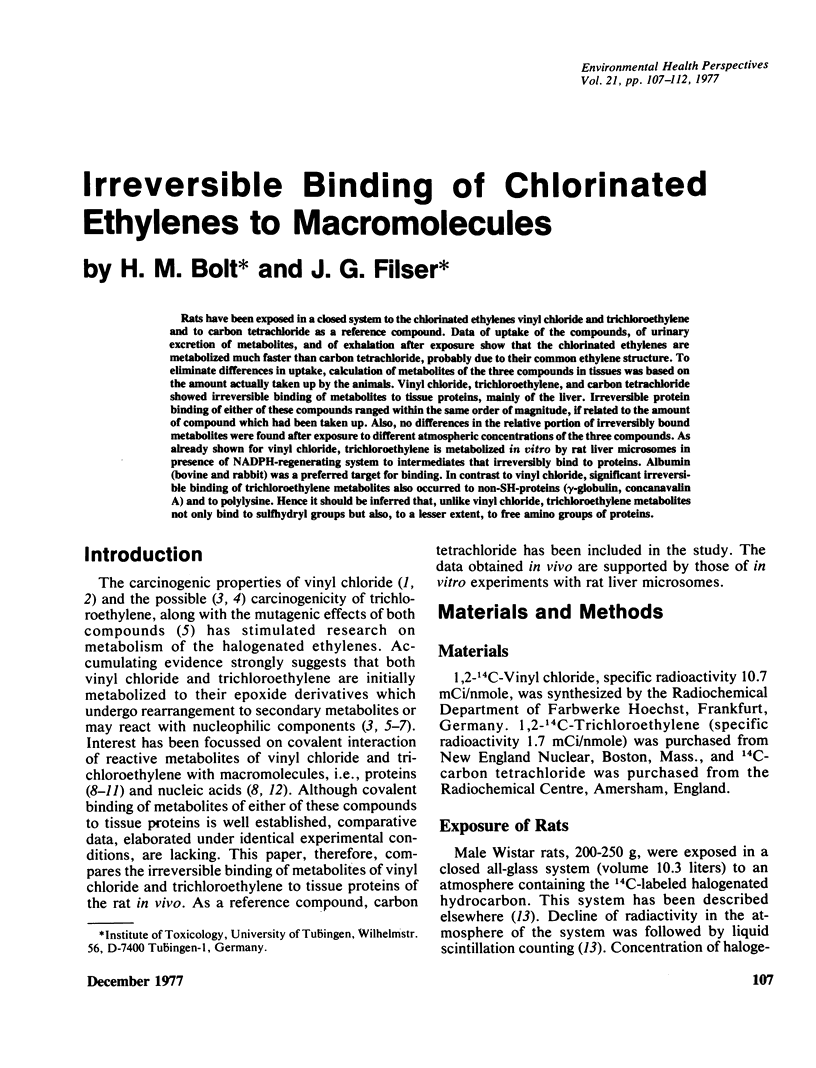
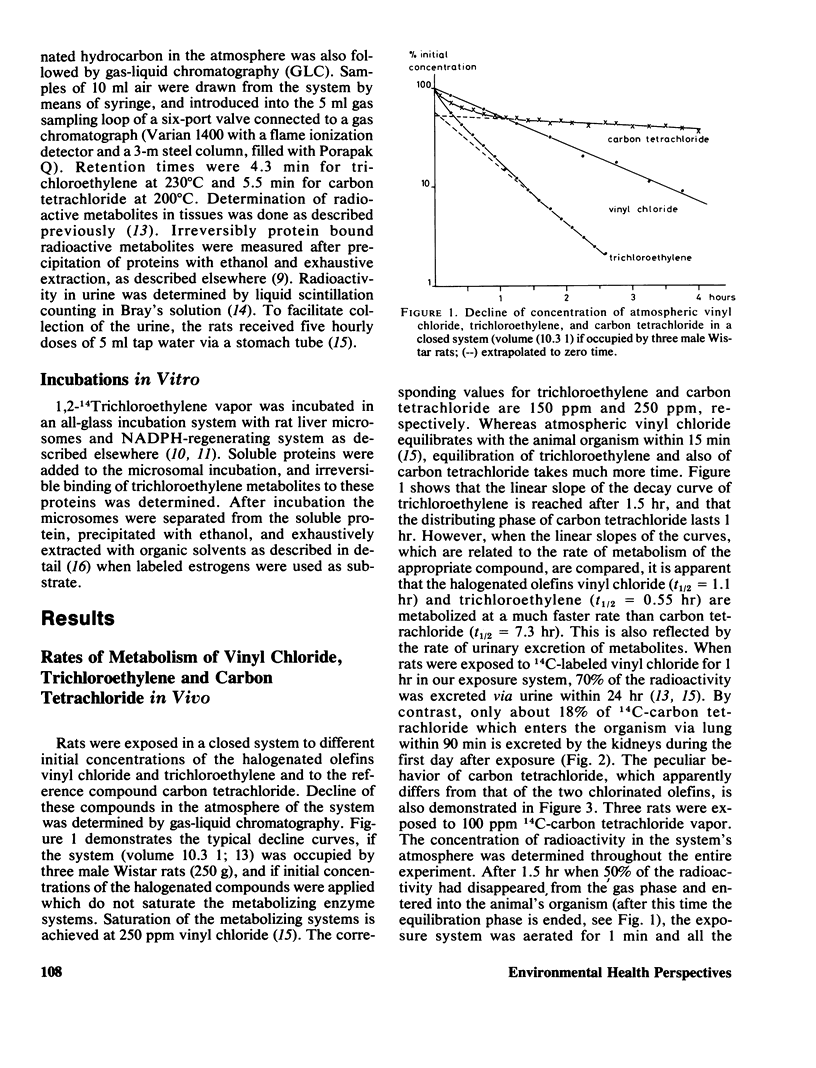
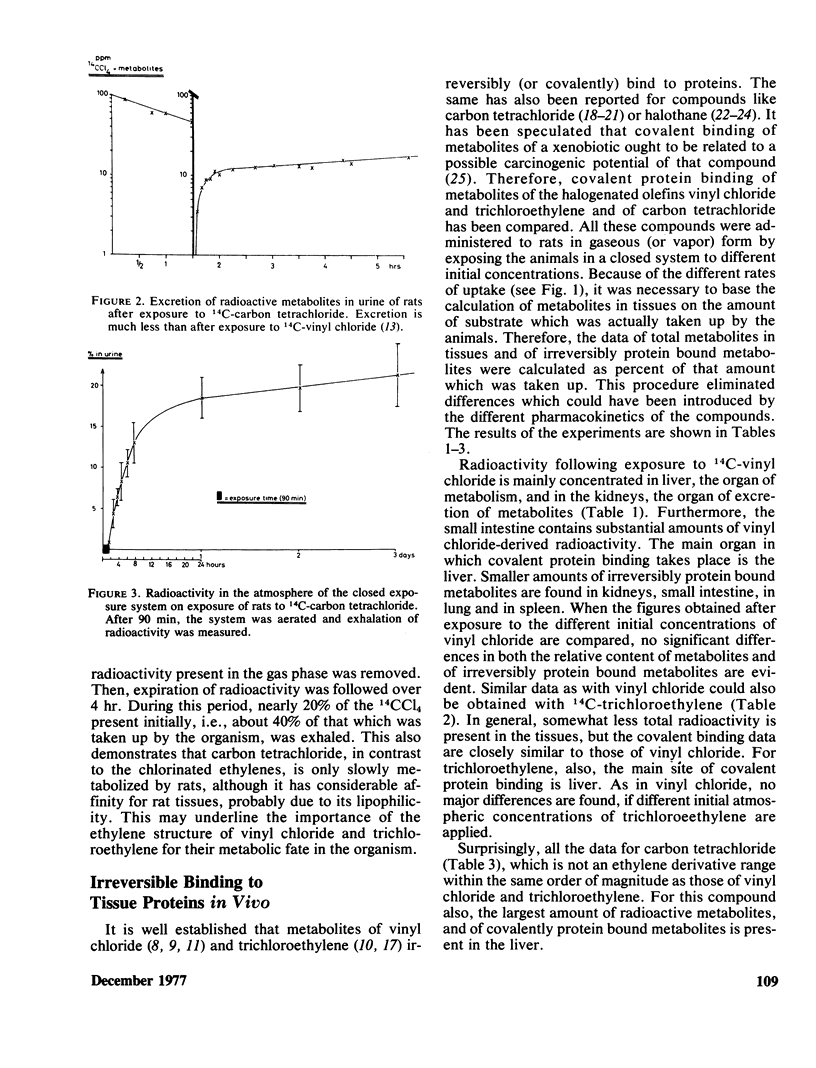
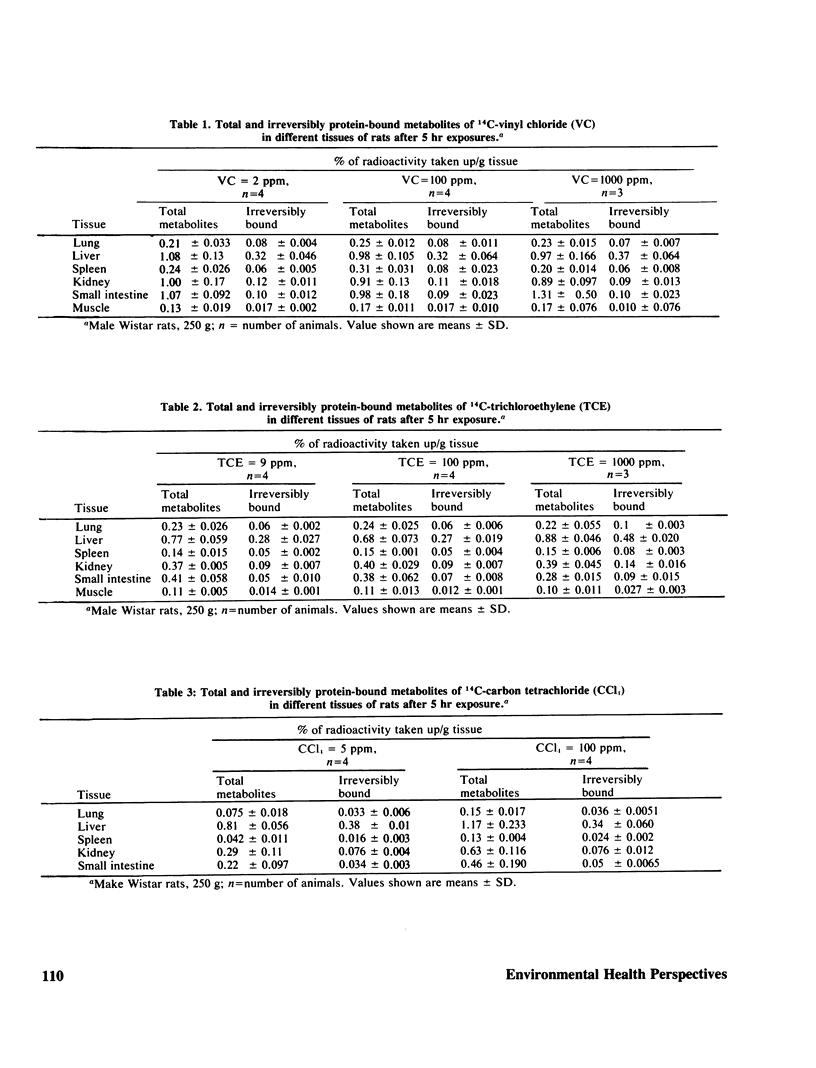
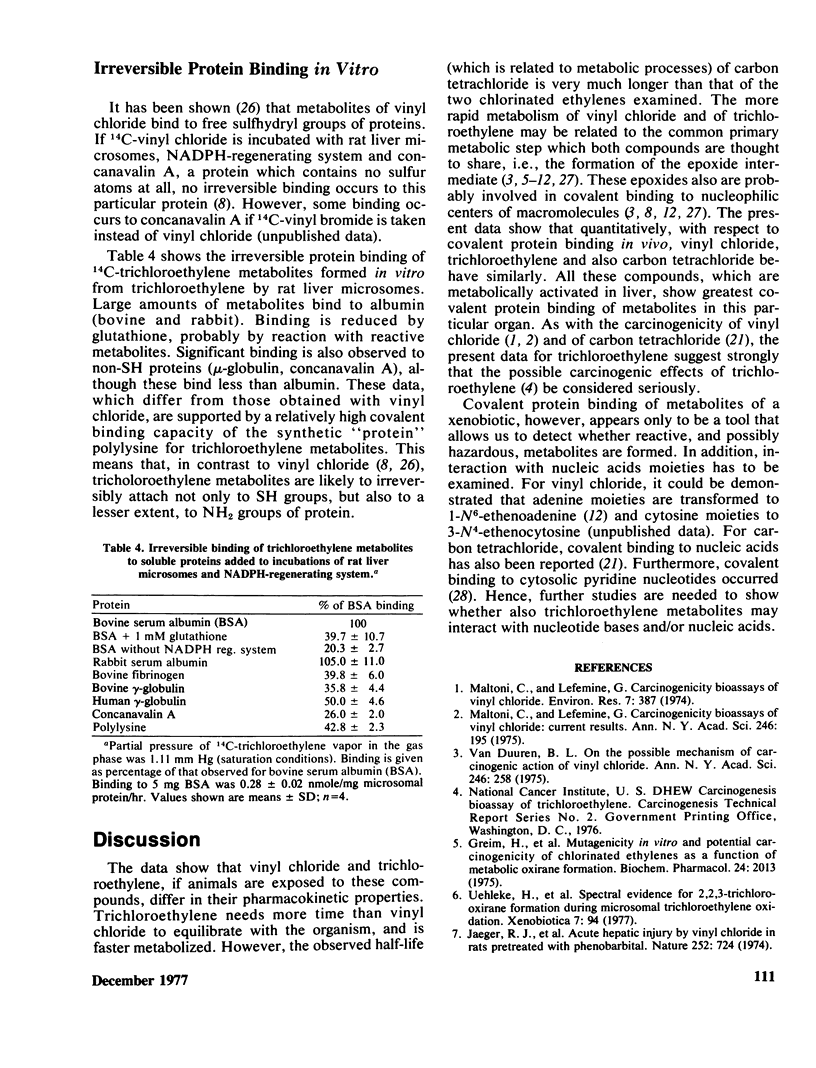
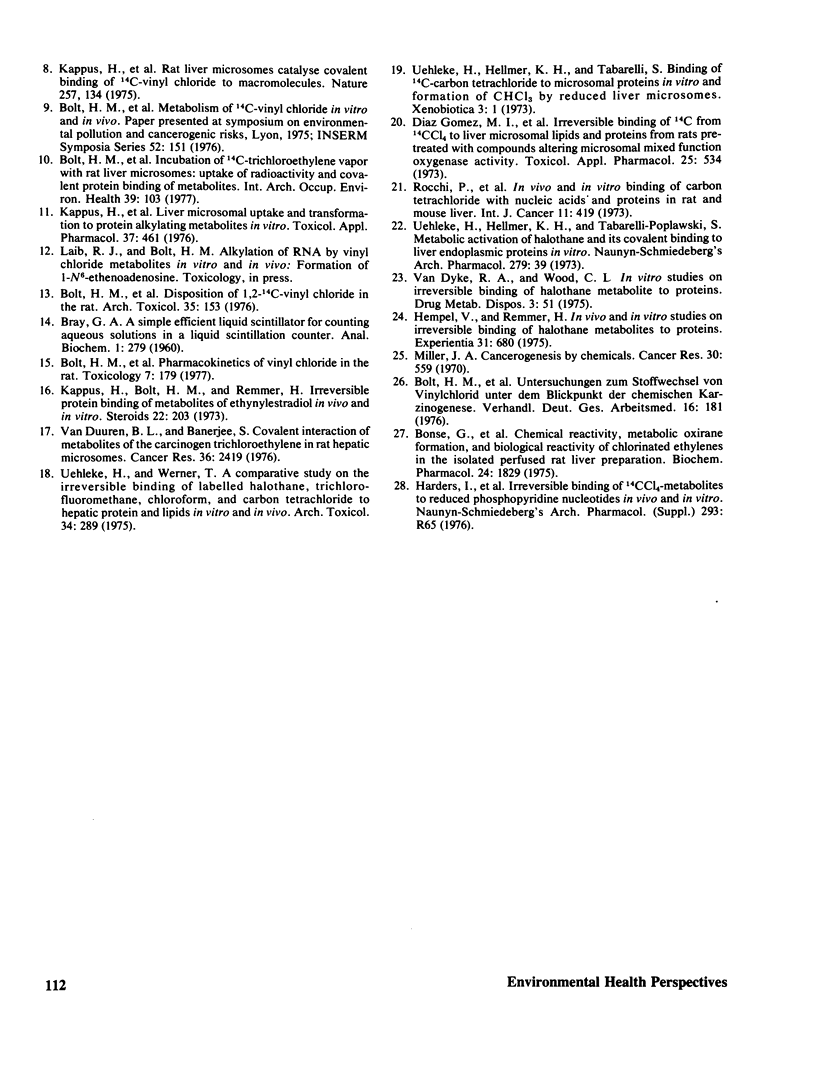
Selected References
These references are in PubMed. This may not be the complete list of references from this article.
- Bolt H. M., Buchter A., Wolowski L., Gil D. L., Bolt W. Incubation of 14C-trichloroethylene vapor with rat liver microsomes: uptake of radioactivity and covalent protein binding of metabolites. Int Arch Occup Environ Health. 1977 Jun 30;39(2):103–111. doi: 10.1007/BF00380890. [DOI] [PubMed] [Google Scholar]
- Bolt H. M., Kappus H., Buchter A., Bolt W. Disposition of (1,2-14C) vinyl chloride in the rat. Arch Toxicol. 1976 Jun 8;35(3):153–162. doi: 10.1007/BF00293562. [DOI] [PubMed] [Google Scholar]
- Bolt H. M., Laib R. J., Kappus H., Buchter A. Pharmacokinetics of vinyl chloride in the rat. Toxicology. 1977 Apr;7(2):179–188. doi: 10.1016/0300-483x(77)90063-4. [DOI] [PubMed] [Google Scholar]
- Bonse G., Urban T., Reichert D., Henschler D. Chemical reactivity, metabolic oxirane formation and biological reactivity of chlorinated ethylenes in the isolated perfused rat liver preparation. Biochem Pharmacol. 1975 Oct 1;24(19):1829–1834. doi: 10.1016/0006-2952(75)90468-2. [DOI] [PubMed] [Google Scholar]
- Díaz Gómez M. I., Castro J. A., de Ferreyra E. C., D'Acosta N., de Castro C. R. Irreversible binding of 14C from 14CCl4 to liver microsomal lipids and proteins from rats pretreated with compounds altering microsomal mixed-function oxygenase activity. Toxicol Appl Pharmacol. 1973 Aug;25(4):534–541. doi: 10.1016/0041-008x(73)90022-7. [DOI] [PubMed] [Google Scholar]
- Greim H., Bonse G., Radwan Z., Reichert D., Henschler D. Mutagenicity in vitro and potential carcinogenicity of chlorinated ethylenes as a function of metabolic oxiran formation. Biochem Pharmacol. 1975 Nov 1;24(21):2013–2017. doi: 10.1016/0006-2952(75)90396-2. [DOI] [PubMed] [Google Scholar]
- Hempel V., Remmer H. In vivo and in vitro studies on irreversible binding of halothane metabolites to proteins. Experientia. 1975 Jun 15;31(6):680–681. doi: 10.1007/BF01944625. [DOI] [PubMed] [Google Scholar]
- Jaeger R. J., Reynolds E. S., Conolly R. B., Moslen M. T., Szabo S., Murphy S. D. Acute hepatic injury by vinyl chloride in rats pretreated with phenobarbital. Nature. 1974 Dec 20;252(5485):724–726. doi: 10.1038/252724a0. [DOI] [PubMed] [Google Scholar]
- Kappus H., Bold H. M., Buchter A., Bolt W. Rat liver microsomes catalyse covalent binding of 14C-vinyl chloride to macromolecules. Nature. 1975 Sep 11;257(5522):134–135. doi: 10.1038/257134a0. [DOI] [PubMed] [Google Scholar]
- Kappus H., Bolt H. M., Buchter A., Bolt W. Liver microsomal uptake of (14C)vinyl chloride and transformation to protein alkylating metabolites in vitro. Toxicol Appl Pharmacol. 1976 Sep;37(3):461–471. doi: 10.1016/0041-008x(76)90208-8. [DOI] [PubMed] [Google Scholar]
- Kappus H., Bolt H. M., Remmer H. Irreversible protein binding of metabolites of ethynylestradiol in vivo and in vitro. Steroids. 1973 Aug;22(2):203–225. doi: 10.1016/0039-128x(73)90086-x. [DOI] [PubMed] [Google Scholar]
- Maltoni C., Lefemine G. Carcinogenicity bioassays of vinyl chloride: current results. Ann N Y Acad Sci. 1975 Jan 31;246:195–218. doi: 10.1111/j.1749-6632.1975.tb51094.x. [DOI] [PubMed] [Google Scholar]
- Miller J. A. Carcinogenesis by chemicals: an overview--G. H. A. Clowes memorial lecture. Cancer Res. 1970 Mar;30(3):559–576. [PubMed] [Google Scholar]
- Rocchi P., Prodi G., Grilli S., Ferreri A. M. In vivo and in vitro binding of carbon tetrachloride with nucleic acids and proteins in rat and mouse liver. Int J Cancer. 1973 Mar 15;11(2):419–425. doi: 10.1002/ijc.2910110219. [DOI] [PubMed] [Google Scholar]
- Uehleke H., Werner T. A comparative study on the irreversible binding of labeled halothane trichlorofluoromethane, chloroform, and carbon tetrachloride to hepatic protein and lipids in vitro and in vivo. Arch Toxicol. 1975 Dec 18;34(4):289–308. doi: 10.1007/BF00353849. [DOI] [PubMed] [Google Scholar]
- Van Duuren B. L., Banerjee S. Covalent interaction of metabolites of the carcinogen trichloroethylene in rat hepatic microsomes. Cancer Res. 1976 Jul;36(7 Pt 1):2419–2422. [PubMed] [Google Scholar]
- Van Duuren B. L. On the possible mechanism of carcinogenic action of vinyl chloride. Ann N Y Acad Sci. 1975 Jan 31;246:258–267. doi: 10.1111/j.1749-6632.1975.tb51101.x. [DOI] [PubMed] [Google Scholar]
- Van Dyke R. A., Wood C. L. In vitro studies on irreversible binding of halothane metabolite to microsomes. Drug Metab Dispos. 1975 Jan-Feb;3(1):51–57. [PubMed] [Google Scholar]


